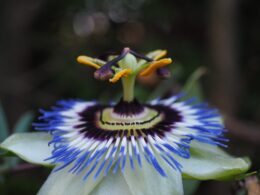About the Floss Flower (Ageratum Houstonianum)
Flossflower (Ageratum houstonianum) is a member of the aster family and is native to Central America. It gets its name from its threadlike, fluff-haired flowers. The plant also has ovate or triangular leaves, and it can be either herbaceous or a dwarf shrub. Other common names include:
- bluemink;
- blueweed;
- pussy foot;
- Mexican paintbrush.
The floss flowers themselves are small and tubular, growing in dense corymbs, and they can be blue, purple, white or pink. The plant blooms from late spring to frost, which usually translates to May–November. It’s relatively easy to grow, and it makes an attractive addition to any garden.
Ageratum Varieties and Cultivars
There are many floss flower varieties to choose from, so it’s easy to find one that suits your taste. They come in different colors, which makes them versatile and never boring – you can always plant another cultivar. Here are some of the most popular!
- ‘Blue Danube’ – this variety has large, lavender blue flowers and grows to be about 8 inches tall. It’s perfect for patios and wildlife gardens.
- ‘Blue Horizon’ – as the name suggests, this one has beautiful purplish-blue flowers. It’s a compact plant that grows to be about 18-30 inches tall, an excellent choice for beds and borders.
- ‘Dwarf Pink Ball’ – this floss flower variety is perfect for containers and small gardens. It has delicate pink flowers and grows to be about 12 inches tall.
- ‘White Bouquet’ – this is a beautiful, pure white flower that’s perfect for edging and cottage gardens. It grows to be about 18-24 inches tall and looks great when planted in mass.
Can you already see which cultivar is your favorite? Think about what would make your garden look best and choose accordingly. A little touch of blue or pink might just be what it needs to liven up!
A Short Guide to Growing Ageratum Flowers
Now that you know all about floss flowers and their different varieties, it’s time to learn how to grow them. Their exact needs might vary slightly between cultivars, but they’re all the same species, so the general rules are the same for all. Here are the basics:
- Choose a location in your garden that gets full sun, or light afternoon shade if you live in a hot climate.
- Prepare the soil by loosening it with a spade and adding some organic matter.
- Sow the seeds in late spring, after the last frost.
- Water regularly, making sure the soil doesn’t dry out – these plants have shallow roots and need constant moisture.
- If the soil is rich enough, you don’t need to fertilize your ageratum. If you notice the leaves yellowing, it might be time to feed it with a dose of balanced, slow-release fertilizer.
- Deadhead spent flowers to encourage new growth. You can also cut the plant back if it starts to look scraggly.
As you can see, this plant is relatively easy to grow and doesn’t require much care. It’s perfect for beginners, so if you’re a new gardener, this might be the plant for you.
Floss flowers can be grown as annuals in zones 2-11, or as tender perennials in zones 10-11. Fortunately, they’ll easily reseed themselves, so you don’t have to worry about replanting them every year.
Pests and Diseases Affecting Ageratums
Although it’s not hard to keep your floss flowers looking good, they can sometimes be affected by diseases. Root rot can occur if the soil drains poorly, so make sure you plant them in a well-draining location. They can also be affected by powdery mildew, which is a white powdery fungus that appears on the leaves.
To prevent fungal diseases, water early in the day so the leaves have time to dry before nightfall. Avoid overhead watering – try to pour the water at the base of the plant. If you notice any affected leaves, remove them immediately and dispose of them in the trash.
Other than that, floss flowers are relatively resistant to pests and diseases. Deer and rabbits stay away from them, and they’re not particularly attractive to insects.
Using Floss Flowers in Bouquets and Arrangements
When your floss flowers are in bloom, you can use them as cut flowers in bouquets and arrangements. They look beautiful on their own or combined with other plants, such as roses, daisies or lavender.
Floss Flower Toxicity
All parts of the floss flower plant are poisonous if ingested, as they contain pyrrolizidine alkaloids. Keep them away from children and pets. The symptoms of poisoning include vomiting, diarrhea, and abdominal pain. If you suspect your child or pet has eaten a floss flower, call your veterinarian or poison control immediately.
Now that you know all about floss flowers, their different varieties and how to grow them, it’s time to add them to your garden! They’ll brighten up any space and bring a touch of color to your yard. Trust us – you won’t be disappointed.
Do you have floss flowers in your garden? Let us know in the comments below!



















